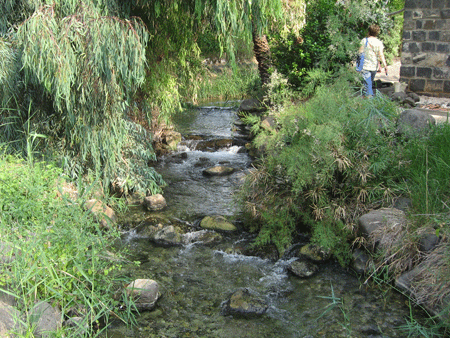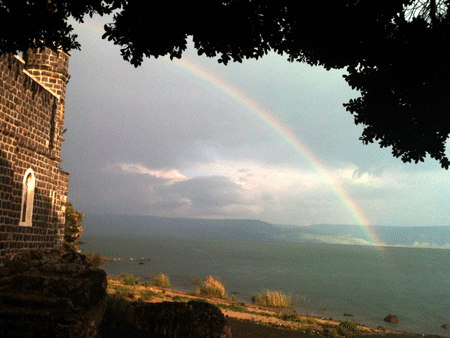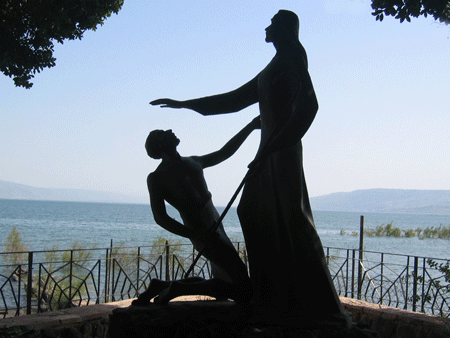|
 |
|
 |
Over Christmas last year, while spending
five nights at the Tabgha Pilgrims Guest
House, I discovered the last rustic
“undeveloped” spot along the shore of the
Sea of Galilee. Where you can almost
hear the call to the fishermen and smell the
two fish and five barley loaves.
Just south of the Tabgha church with the
most-photographed mosaic in the country is a
wooded area with overgrown pathways and huge
distinctive basalt stones framed by tiny
pebbles. Perch yourself upon a flat
rock and face the sea – it’s a perfect place
to contemplate “the call” to the disciples,
study the feeding of the 5,000, write
poetry, or pray. |
|
|
|
 |
|
Photo:
Gila Yudkin |
|
Along the Sea of Galilee
south of the Benedictine Tabgha church |
|
|
You are sitting at Tabgha, an Arabic
corruption of the Greek name Heptapegon,
which means seven springs. The feeding
of the 5,000 has been commemorated in this
fertile valley since the fourth century when
the Byzantines built the first small chapel.
This was probably the shrine described by a
Spanish (or French) pilgrim named Egeria who
traveled solo throughout the Holy Land for
three years in the 380s AD. Egeria
wrote to her network of female friends back
home, |
|
"In the same place (not far from
Capernaum) facing the Sea of Galilee is a
well watered land in which lush grasses
grow, with numerous trees and palms. Nearby are seven springs which provide
abundant water. In this fruitful garden
Jesus fed five thousand people with five
loaves of bread and two fish. The stone
upon which the Master placed the bread
became an altar. The many pilgrims to the
site broke off pieces of it as a cure for
their ailments."
|
|
 |
|
Photo:
Gila Yudkin |
|
5 of the springs at Tabgha
are still active |
|
The feeding of the five thousand is the only
miracle mentioned in all four gospels, yet
each gospel places the event in a slightly
different setting. In Matthew there are no
hints as to location. Jesus is in a solitary
place and the crowds leave the towns to come
to him. The disciples with him suggest that
because of the late hour, he send the crowds
to the villages to buy food. Then after the
miracle, Jesus dismisses the crowds and goes
up to the mountain by himself to pray.
(Matthew 14)
In the Gospel of Mark, Jesus is in a
deserted place where the disciples and
people from the towns hurried to him. People
sit down in groups on the green grass which
tells us the event takes place before
Passover when the rain ceases. Afterwards
Jesus orders his disciples to get into the
boat and go ahead to the other side, to
Bethsaida, on the northern shore. (Mark 6) |
|
| Luke chapter 9 places the miracle by
Bethsaida and in John chapter 6, Jesus turns
to Philip, a native of Bethsaida, and asks,
“Where shall we buy bread for such a large
crowd?” This suggests that the multitude
may have
gathered in an area close to Bethsaida. After the feeding of the 5,000, Jesus
withdrew alone to the mountain and the
disciples “crossed” the sea to Capernaum. |
|
Although the geography is seemingly
contradictory, the miracle itself is
identical in each gospel: it’s a lonely
place; the hour is late; the people are
hungry; five barley loaves and two fish are
offered up by the crowd; 5,000 men plus
women and children eat; 12 baskets are
filled with leftovers.
The quiet untouched wooded area of Tabgha
with its bubbling springs creates an
authentic setting where the pastor or
teacher can give meaning and relevance to
the calling of the disciples and the miracle
of the feeding of the 5,000. |
|
If you are Catholic and have a priest
in your group, ask your tour leader to
arrange a mass at the outdoor Benedictine
site at Tabgha, right by the sea. It will
touch your spirit.
If not, there is another option. If you
enjoy a steamy hot shower, yet willing to
forgo TV, the Tabgha Pilgerhaus offers
simple, comfortable accommodations, and an
atmosphere conducive to study, thought,
prayer and fellowship. Over three decades of
guiding, I have stayed in every major and
minor hotel in Tiberias, including those
which have changed their names five times.
I’ve also lodged on the western, eastern and
southern shores and slopes of the sea. This
is my favorite. |
|
|
|
Copyright 2010, 2015 Gila Yudkin. Permission
needed for any reuse. |
|
|
|
Gila Yudkin, a Connecticut-born Yankee
living in King David’s Court, is always on
the lookout for authentic natural sites to
celebrate gospel events and miracles.
Gila is also on the lookout for groups
thirsty for biblical insight, archeological
anecdotes and old-fashioned fun. She
wishes she could take a time journey back to
Galilee in Egeria’s time in the fourth
century, or better yet, to the Galilee of
the first century. |
|
|
|
 |
|
Photo:
Gila Yudkin |
|
Basket of loaves and two
fish: most photographed mosaic in the
holy land |
|
|
|
 |
|
Photo
courtesy of Jane Ben Ari |
|
Rainbow over the Sea of
Galilee at Tabgha |
|
|
|
 |
|
Photo:
Gila Yudkin |
|
Jesus says to Peter, "Feed
my sheep," John 21 |
|
|
|
Read what archeology has revealed about
Bethsaida in the time of
Jesus. |
|
|

